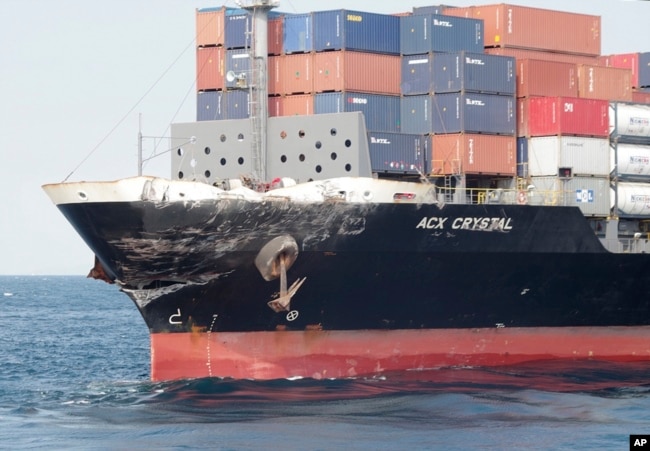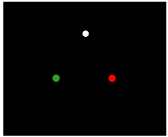USS Fitzgerald Collides with Japanese Merchant Ship...

US Navy Destroyer Collides with Japanese Merchant Ship
16 Jun 2017 | Updated 10:29 p.m. Eastern Standard Time
See also:
Search goes on for seven U.S. sailors after collision off Japan
Sat Jun 17, 2017 | Rescue crews searched into the early hours on Sunday for seven American sailors missing after a U.S. destroyer collided with a container ship in the pre-dawn hours off the coast of Japan.
Related:
Missing USS Fitzgerald Sailors Found Dead
June 17, 2017 — The U.S. Navy says its divers have accessed a flooded compartment on the USS Fitzgerald and found the bodies of a number of the sailors missing in a collision between the Navy destroyer and a merchant vessel. It is not clear how many bodies were recovered.

US Navy Destroyer Collides with Japanese Merchant Ship
16 Jun 2017 | Updated 10:29 p.m. Eastern Standard Time
U.S. and Japanese ships and aircraft rushed to help a Navy destroyer and medically evacuate at least three personnel -- including the commanding officer -- after a collision with a merchant ship southwest of Yokosuka, Japan. Navy officials were assessing the damage to the Arleigh Burke-class guided missile destroyer USS Fitzgerald, which officials said was damaged below the water line and experienced flooding. Seven sailors remain unaccounted for, the service said in a statement late Friday. A Japanese television news outlet captured overhead footage of the destroyer that showed crush damage to the starboard, or right, side of the ship, including its deckhouse.
In a statement published just after 6 p.m. EST, Chief of Naval Operations Adm. John Richardson indicated the severity of the incident was still unclear. "As more information is learned, we will be sure to share to it with the Fitzgerald families and when appropriate the public," he said in the message. "Thank you for your well wishes and messages of concern. All of our thoughts and prayers are with the Fitzgerald crew and their families." The Japanese Coast Guard is searching for the seven missing sailors, 7th Fleet said in a statement. In a separate message on its Facebook page, 7th Fleet said two sailors in addition to Cmdr. Bryce Benson, the commanding officer, were medically evacuated from the destroyer to U.S. Naval Hospital-Yokosuka for lacerations and bruises.

The Arleigh Burke class guided-missile destroyer USS Fitzgerald (DDG 62) on patrol in support of security and stability in the Indo-Asia-Pacific region
The collision happened around 2:30 a.m. Saturday local time. An official familiar with the incident could not confirm which country the merchant vessel hailed from, but characterized it as large and like a container ship. The Associated Press identified the vessel as the container ship Philippine ACX Crystal from the Philippines. The Fitzgerald had been conducting routine operations in Sagami Bay, about 56 nautical miles southwest of Yokosuka, a Pacific Fleet spokesman, Lt. Cmdr. Matt Knight, told Military.com. The destroyer sustained damage on the right side above and below the waterline, resulting in some flooding, according to 7th Fleet. The vessel was operating under her own power, but with limited propulsion.
Navy officials requested and were receiving assistance from the Japanese Coast Guard, Knight said. The service's cutters Izunami and Kano were assisting, according to 7th Fleet. The destroyer USS Dewey (DDG 105), medical assistance and two Navy tugs were also being dispatched to provide assistance, 7th Fleet said. Naval aircraft were also being readied, it said. An investigation into the incident is planned. The Fitzgerald is assigned to the 5th Carrier Strike Group, which is led by the carrier Ronald Reagan and operates out of Japan.
US Navy Destroyer Collides with Japanese Merchant Ship | Military.com
See also:
Search goes on for seven U.S. sailors after collision off Japan
Sat Jun 17, 2017 | Rescue crews searched into the early hours on Sunday for seven American sailors missing after a U.S. destroyer collided with a container ship in the pre-dawn hours off the coast of Japan.
Rescue crews searched into the early hours on Sunday for seven American sailors missing after a U.S. destroyer collided with a container ship in the pre-dawn hours off the coast of Japan. U.S. 7th Fleet Vice Admiral Joseph P. Aucoin said the search was continuing in a statement released nearly 24 hours after the USS Fitzgerald, an Aegis guided missile destroyer, collided with the much larger Philippine-flagged merchant vessel 56 nautical miles southwest of Yokosuka. "It's been a tough day for our Navy family. It's hard to imagine what this crew has had to endure, the challenges they've had to overcome," Aucoin said.

The Arleigh Burke-class guided-missile destroyer USS Fitzgerald, damaged by colliding with a Philippine-flagged merchant vessel, is towed into the U.S. naval base in Yokosuka, south of Tokyo, Japan
U.S. and Japanese aircraft and surface vessels continued the search after the Fitzgerald sailed into the port of Yokosuka south of Tokyo. Three aboard the destroyer were treated at the U.S. Naval Hospital, including ship Commander Bryce Benson. It was not clear what caused the collision, which the U.S. Navy said occurred at about 2:30 a.m. local time (1730 GMT). "Thoughts and prayers with the sailors of USS Fitzgerald and their families. Thank you to our Japanese allies for their assistance," U.S. President Donald Trump said in a Twitter post on Saturday.

The Arleigh Burke-class guided-missile destroyer USS Fitzgerald returns to Fleet Activities (FLEACT) Yokosuka following a collision with a merchant vessel while operating southwest of Yokosuka, Japan
The Fitzgerald suffered damage on her starboard side above and below the waterline, the Navy said. Japan's Nippon Yusen KK, which charters the container ship, ASX Crystal, said in a statement it would "cooperate fully" with the Coast Guard's investigation of the incident. At around 29,000 tons displacement, the ship dwarfs the 8,315-ton U.S. warship, and was carrying 1,080 containers from the port of Nagoya to Tokyo. None of the 20 crew members aboard the container ship, all Filipino, were injured, and the ship was not leaking oil, Nippon Yusen said. The ship arrived at Tokyo Bay later in the day. The waterways approaching Tokyo Bay are busy with commercial vessels sailing to and from Japan’s two biggest container ports in Tokyo and Yokohama.
Search goes on for seven U.S. sailors after collision off Japan
Related:
Missing USS Fitzgerald Sailors Found Dead
June 17, 2017 — The U.S. Navy says its divers have accessed a flooded compartment on the USS Fitzgerald and found the bodies of a number of the sailors missing in a collision between the Navy destroyer and a merchant vessel. It is not clear how many bodies were recovered.
The search will continue Sunday both on the ship and at sea until all of the missing sailors are found. The USS Dewey and other American and Japanese vessels and aircraft are involved in the search, the U.S. Navy said.
Collision at sea
The USS Fitzgerald collided early Saturday with the merchant vessel ACX Crystal — a ship about four times the size of the destroyer — off the coast of Japan. The 29,000-ton Philippine ship is 222 meters long, while the 8,315-ton Navy destroyer is 154 meters long. The U.S. Navy said the collision occurred about midship on the starboard side, damaging two sailor berthing stations, a machinery room and a radio room. The USS Fitzgerald returned to port at Yokosuka, Japan. The destroyer sustained damage above and below the water line, and had “experienced flooding in some spaces,” the U.S. Navy said. The missing sailors’ names are being withheld, pending notification of their families.
Injured sailors
In addition to the missing sailors, three other sailors, including ship Commander Bryce Benson, were injured. Benson was airlifted to the U.S. Naval Hospital in Yokosuka and was in stable condition with a head injury. The two other sailors suffered cuts and bruises and were taken off the ship. It was unclear how many others may have been injured in the collision, which occurred about 100 kilometers southwest of Yokosuka at 2:30 a.m. Saturday local time, according to the Navy’s 7th Fleet, which operates in the Western Pacific and Indian Ocean.

The damage of Philippine-registered container ship ACX Crystal is seen in the waters off Izu Peninsula, southwest of Tokyo, after it had collided with the USS Fitzgerald
At that time, many of the 200 sailors aboard the USS Fitzgerald would have been sleeping in their berths. “It’s been a tough day for our Navy family,” Vice Adm. Joseph Aucoin, the commander of the 7th Fleet, said Saturday. “I am humbled by the bravery and tenacity of the Fitzgerald crew. Now that the ship is in Yokosuka, I ask that you help the families by maintaining their privacy as we continue the search for our shipmates.” On Saturday, President Donald Trump said on Twitter: “Thoughts and prayers with the sailors of USS Fitzgerald and their families. Thank you to our Japanese allies for their assistance.”
Missing USS Fitzgerald Sailors Found Dead


